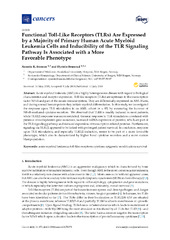Functional toll-like receptors (TLRs) are expressed by a majority of primary human acute myeloid leukemia cells and inducibility of the TLR signaling pathway is associatedwith a more favorable phenotype
Peer reviewed, Journal article
Published version

Åpne
Permanent lenke
https://hdl.handle.net/1956/20814Utgivelsesdato
2019-07-11Metadata
Vis full innførselSamlinger
Originalversjon
https://doi.org/10.3390/cancers11070973Sammendrag
Acute myeloid leukemia (AML) is a highlyheterogeneous disease withregardto biological characteristics and receptor expression. Toll-like receptors (TLRs) are upstream to the transcription factor NFκB and part of the innate immune system. They are differentially expressed on AML blasts, and during normal hematopoiesis they initiate myeloid differentiation. In this study, we investigated the response upon TLR stimulation in an AML cohort (n = 83) by measuring the increase of NFκB-mediated cytokine secretion. We observed that TLR4 is readily induced in most patients, while TLR1/2 response was more restricted. General response to TLR stimulation correlated with presence of nucleophosmin gene mutations, increased mRNA expression of proteins, which are part of the TLR signaling pathway and reduced expression of transcription-related proteins. Furthermore, signaling via TLR1/2 appeared to be linked with prolonged patient survival. In conclusion, response upon TLR stimulation, and especially TLR1/2 induction, seems to be part of a more favorable phenotype, which also is characterized by higher basal cytokine secretion and a more mature blast population.
